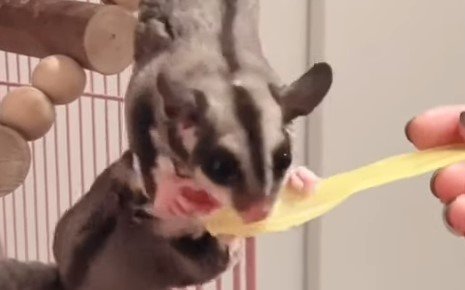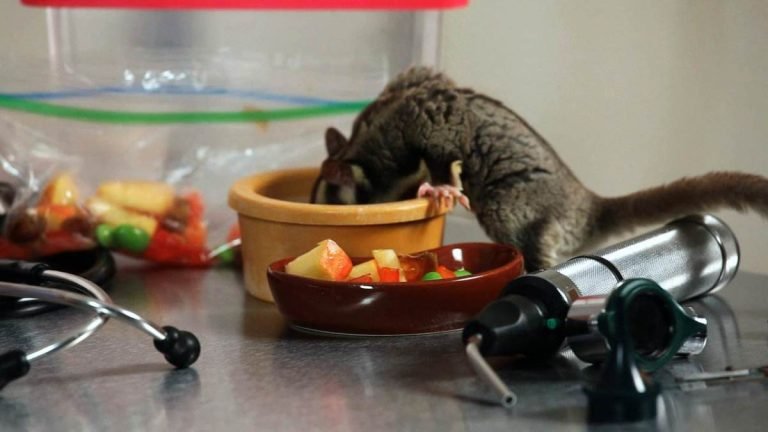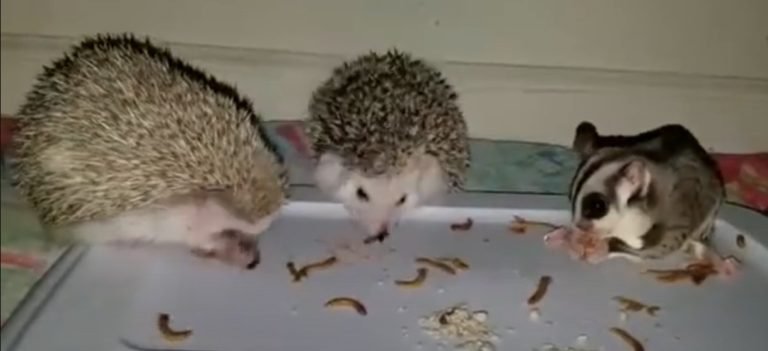Sugar Glider Treats Fruits VS Insects Treat Choices
Did you know that sugar gliders have unique dietary needs? Choosing the right treats for these adorable marsupials is crucial to their well-being. Fruits and insects offer distinct benefits for these little creatures from New Guinea.
Fresh fruit is not only a tasty delight but also provides essential nutrients to fuel your sugar glider’s active lifestyle. On the other hand, insects are natural prey for these small animals, tapping into their instincts as predators. But which option should you prioritize?
Understanding the nutritional requirements of sugar gliders can help you make informed decisions about their treat choices. By incorporating both fruits and insects into their diet, you can ensure a balanced and varied meal plan for your furry friend.
Join us as we delve into the world of sugar glider treats, exploring how different options contribute to their overall health and happiness. So let’s cut to the chase and uncover the secrets behind this delightful dilemma!
Nutritional benefits of fruits for sugar gliders
- Fruits provide essential vitamins and minerals that support the overall health of sugar gliders.
- The natural sugars found in fruits offer a source of energy for active sugar gliders.
- Apples and grapes are rich in antioxidants, promoting a strong immune system in sugar gliders.
- Incorporating a variety of fruits into your sugar glider’s diet ensures they receive a range of nutrients.
Fruits play a crucial role in providing vital nutrition to sugar gliders. These small marsupials require a well-balanced diet to thrive, and incorporating fruits can be an excellent way to meet their nutritional needs. Here’s why:
- Essential vitamins and minerals: Fruits are packed with essential vitamins and minerals that contribute to the overall health of sugar gliders. These nutrients help support various bodily functions and ensure optimal development. For instance, vitamin C from fruits like oranges helps boost the immune system, while vitamin A promotes healthy eyesight.
- Energy source: The natural sugars present in fruits serve as an excellent energy source for active sugar gliders. As these creatures are highly energetic, they require fuel to sustain their active lifestyles. Snacking on fruits provides them with the necessary carbohydrates to stay agile and playful throughout the day.
- Antioxidant-rich options: Certain fruits such as apples and grapes contain high levels of antioxidants. These compounds help combat harmful free radicals within the body, reducing oxidative stress and promoting a strong immune system in sugar gliders. By including antioxidant-rich fruits in their diet, you can enhance their ability to fight off illnesses effectively.
- Nutrient variety: Just like humans, sugar gliders benefit from consuming a diverse range of nutrients. By offering them different types of fruit, you ensure they receive a wide array of vitamins, minerals, and other beneficial compounds necessary for their well-being. Consider including options like bananas, berries, melons, and papayas to provide a varied diet.
Remember, while fruits are an essential part of a sugar glider’s diet, they should be offered in moderation alongside other appropriate foods. A balanced approach that includes both fruits and insects will help ensure your sugar glider receives all the necessary nutrients for a healthy and happy life.
Nutritional benefits of insects for sugar gliders

Sugar gliders require a balanced diet to thrive, and incorporating insects into their meals offers several important nutritional benefits:
- Protein Powerhouse: Insects are an exceptional source of protein, essential for muscle development in sugar gliders. This nutrient plays a vital role in maintaining their overall health and vitality.
- Mimicking Their Natural Diet: By feeding insects to your sugar glider, you can replicate their natural diet in the wild. Insects form a significant part of their food sources, allowing them to fulfill their instinctual dietary needs.
- Nutrient-Rich Options: Mealworms and crickets are commonly chosen as insect treats for sugar gliders due to their high nutritional value. These options provide an abundance of essential nutrients necessary for the well-being of your furry friend.
- Healthy Skin and Coat: In addition to protein, insects also contain essential fatty acids that support healthy skin and coat in sugar gliders. These fatty acids contribute to maintaining a lustrous fur coat and promoting optimal skin health.
By incorporating insects into your sugar glider’s treat choices, you can ensure they receive the necessary nutrients while emulating their natural diet. Protein-rich insects like mealworms and crickets offer numerous health benefits, including muscle development and healthy skin/coat maintenance.
Preferences of Sugar Gliders in Treat Choices
Sugar gliders, just like humans, have individual preferences. Understanding what your pet glider enjoys can help you provide them with the most satisfying snacks. Here are some key points to consider:
- Sweet vs Savory: Some sugar gliders may have a sweet tooth and prefer treats that are fruity and sugary, while others may lean towards savory options like insects. It’s important to observe their reactions and behavior to determine their taste preferences.
- Experimentation is Key: To find out what treats your sugar glider loves the most, it’s essential to experiment with different options. Offering a variety of fruits and insects will allow you to gauge their preferences accurately.
- Observing Reactions: Paying attention to your sugar glider’s reactions is crucial in understanding their favorite types of treats. Look for signs of excitement or increased interest when certain treats are offered. This will give you insights into what they truly enjoy.
Sugar gliders are social animals that require proper care and an enriching habitat. By catering to their treat preferences, you can create a happy environment for your pet glider. Remember these tips when selecting treats:
- Variety Matters: Providing a diverse range of treats ensures that your sugar glider gets all the necessary nutrients while enjoying different flavors.
- Balanced Diet: While fruits offer natural sugars and vitamins, insects provide protein and other essential nutrients. Finding the right balance between these two treat options is important for your pet’s overall health.
Selecting healthy and appropriate treats for sugar gliders
Opting for fresh, organic fruits ensures that your sugar glider receives the highest quality treats. By choosing fruits that are free from pesticides or chemicals, you can prioritize the health and well-being of your sugar gliders. Selecting insects as treats requires caution to ensure they come from reputable sources and are free from harmful substances.
To provide a balanced diet for your sugar gliders, it is crucial to offer treats in moderation. This helps prevent nutritional imbalances and maintains their overall health. Consider incorporating a variety of natural options into their diet to mimic their wild eating habits.
Here are some key points to keep in mind when selecting treats for your sugar gliders:
- Fresh, organic fruits: Opt for fresh fruits that are free from pesticides or chemicals. This ensures that your sugar glider receives nutritious and safe treats.
- Reputable insect sources: When choosing insects as treats, ensure they come from reputable suppliers. This guarantees that they are free from harmful substances.
- Moderation: Offer treats in moderation to prevent nutritional imbalances. Remember that while these treats can be enjoyable for sugar gliders, their main diet should consist of a balanced mix of proteins, fruits, vegetables, gum, tree sap, and other natural foods.
- Mimic their natural diet: Sugar gliders have a diverse range of food preferences in the wild. Try to replicate this by offering them a variety of suitable options such as insects and organic fruits.
By following these guidelines and considering the specific needs of your sugar gliders, you can select healthy and appropriate treats that contribute to their overall well-being. Remember to consult with a veterinarian experienced in exotic pet care if you have any concerns about their dietary choices or health.
Common Mistakes to Avoid with Sugar Glider Treats
Giving Harmful Human Foods
Avoid giving sugary or processed human foods as treats to sugar gliders. These can be harmful and have negative effects on their health.
Toxic Fruits to Steer Clear Of
Be cautious of certain fruits that can be toxic to sugar gliders. Avocados and cherries, for example, should not be included in their diet as they can be poisonous.
Portion Control is Crucial
Overfeeding treats can lead to obesity and various health issues in sugar gliders. It’s important to practice portion control when offering treats to your furry friends.
The Importance of Variety
Neglecting variety in treat choices may result in nutrient deficiencies for your sugar glider. Ensure that you provide a diverse range of treats to meet their nutritional needs.
By avoiding sugary or processed human foods, steering clear of toxic fruits like avocados and cherries, practicing portion control, and offering a variety of treats, you can keep your sugar glider healthy and happy. Remember, these small adjustments can make a big difference in their overall well-being.
Conclusion
In conclusion, it’s important to make the right choices. Both fruits and insects offer nutritional benefits that can contribute to your pet’s overall health and well-being.
Fruits provide essential vitamins and minerals that are necessary for a balanced diet. They offer natural sugars that can give your sugar glider an energy boost. The variety of flavors and textures in fruits can cater to their preferences.
On the other hand, insects are a great source of protein for sugar gliders. They contain essential amino acids that aid in muscle development and growth. Insects also provide enrichment as they simulate natural hunting behaviors for these small marsupials.
When choosing treats for your sugar glider, consider their preferences. Some gliders may have a particular liking towards certain fruits or insects, so it’s important to observe their reactions and adjust accordingly.
Ensure you select healthy and appropriate treats by avoiding common mistakes such as offering sugary processed foods or toxic substances like chocolate. Stick to natural options that align with their dietary needs.
Remember the E-E-A-T concept: Expertise, Authoritativeness, Trustworthiness. Seek reliable sources of information when making decisions about your sugar glider’s diet.
To ensure you’re providing the best care for your furry friend, consult with a veterinarian who specializes in exotic pets. They can provide personalized advice based on your specific sugar glider’s needs.
Take charge of your sugar glider’s health by making informed treat choices today!
FAQs
1.Can I feed my sugar glider only fruits as treats?
While fruits are beneficial for sugar gliders, it is recommended to offer a varied diet that includes other food sources such as insects to ensure they receive all necessary nutrients.
2.Are there any fruits or insects I should avoid feeding my sugar glider?
Yes, some fruits like grapes and avocados can be toxic to sugar gliders. Insects should also be sourced from reputable suppliers to avoid potential pesticide contamination.
3.How often should I give treats to my sugar glider?
Treats should be given in moderation and as part of a balanced diet. It’s best to consult with a veterinarian to determine the appropriate frequency based on your sugar glider’s specific needs.
4.Can I offer treats as a form of training reward for my sugar glider?
Yes, treats can be used as positive reinforcement during training sessions with your sugar glider. However, make sure the treats are small and healthy to avoid overfeeding.
5.What are some signs that my sugar glider is not enjoying a particular treat?
If your sugar glider refuses or shows disinterest in a specific treat, it may indicate that they do not enjoy its taste or texture. Experiment with different options to find what they prefer.







